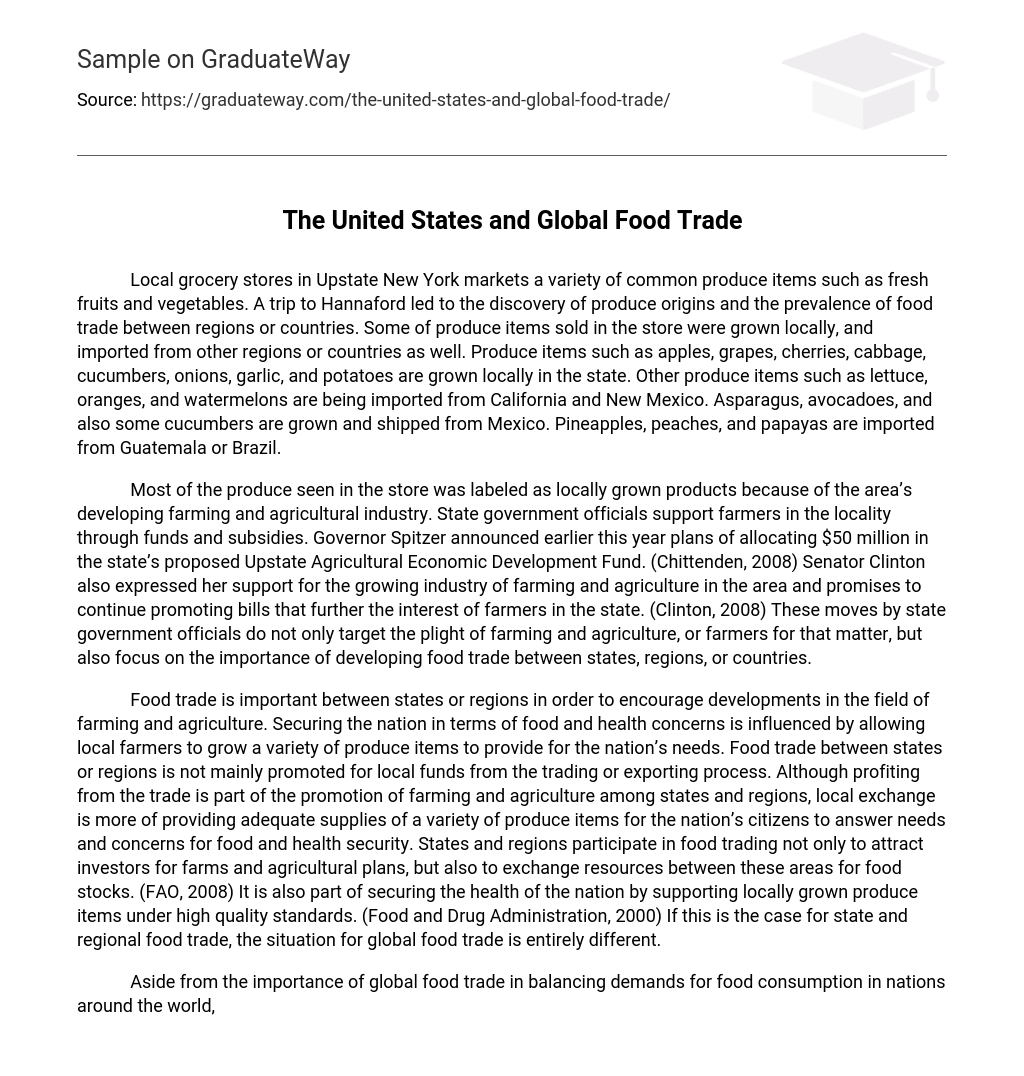Local grocery stores in Upstate New York markets a variety of common produce items such as fresh fruits and vegetables. A trip to Hannaford led to the discovery of produce origins and the prevalence of food trade between regions or countries. Some of produce items sold in the store were grown locally, and imported from other regions or countries as well. Produce items such as apples, grapes, cherries, cabbage, cucumbers, onions, garlic, and potatoes are grown locally in the state. Other produce items such as lettuce, oranges, and watermelons are being imported from California and New Mexico. Asparagus, avocadoes, and also some cucumbers are grown and shipped from Mexico. Pineapples, peaches, and papayas are imported from Guatemala or Brazil.
Most of the produce seen in the store was labeled as locally grown products because of the area’s developing farming and agricultural industry. State government officials support farmers in the locality through funds and subsidies. Governor Spitzer announced earlier this year plans of allocating $50 million in the state’s proposed Upstate Agricultural Economic Development Fund. (Chittenden, 2008) Senator Clinton also expressed her support for the growing industry of farming and agriculture in the area and promises to continue promoting bills that further the interest of farmers in the state. (Clinton, 2008) These moves by state government officials do not only target the plight of farming and agriculture, or farmers for that matter, but also focus on the importance of developing food trade between states, regions, or countries.
Food trade is important between states or regions in order to encourage developments in the field of farming and agriculture. Securing the nation in terms of food and health concerns is influenced by allowing local farmers to grow a variety of produce items to provide for the nation’s needs. Food trade between states or regions is not mainly promoted for local funds from the trading or exporting process. Although profiting from the trade is part of the promotion of farming and agriculture among states and regions, local exchange is more of providing adequate supplies of a variety of produce items for the nation’s citizens to answer needs and concerns for food and health security. States and regions participate in food trading not only to attract investors for farms and agricultural plans, but also to exchange resources between these areas for food stocks. (FAO, 2008) It is also part of securing the health of the nation by supporting locally grown produce items under high quality standards. (Food and Drug Administration, 2000) If this is the case for state and regional food trade, the situation for global food trade is entirely different.
Aside from the importance of global food trade in balancing demands for food consumption in nations around the world, it also plays a role in the economy of each nation. The ability to grow export quality products means that nations are able to gain profit from the process of global trade. Profit from exports may well be used to purchase produce imports demanded by the nation. Therefore, global trade stabilizes a nation’s economy. Moreover, profit is also gained from local or foreign investors that are interested in supporting the farming and agricultural industry through funds in order to improve farming and agricultural knowledge and skills, as well as facilities used in both areas. Globe trade also promotes diplomacy or desirable relations with other nations. (Gehlhar & Coyle, 2001)
The United States is highly dependent on global food trade. Perhaps, eliminating food trade policies in the country will paralyze the economy. For the U.S., food trade means more job opportunities for its citizens, income for the country, and also purchasing power for needs and demands not only in the industry of farming and agriculture but with other non-related needs of the nation. (Edmondson, 2008) Due to these reasons, the country is actively involved in both regional and international food trade systems. Aside from agricultural products exported by the United States, the country also leads exports in cotton, dairy products, meat and poultry, hides and skins, coal, fuel oil, iron and steel, and other mineral resources. Other exports include computers, automobile, telecommunications equipment, etc. (FTD, 2008) Import products shipped to the U.S. are varied types of equipments, manufactured goods, hydrocarbons as well as several types of chemicals. (Alibaba, 2006)
References
Alibaba. (2006). “United States.” Retrieved September 8, 2008, from Alibaba.com Limited.
Website: http://country.alibaba.com/profiles/US/United_States.htm
Chittenden, J. A. (2008). “Farmers Demonstrate Strong Support for Governor Spitzer’s Upstate
Revitalization Plan.” Retrieved September 7, 2008, from New York State Department of Agriculture and Markets. Website: http://agmkt.state.ny.us/AD/release.asp?ReleaseID=1679
Clinton, H. R. (2008). “Agriculture.” Retrieved September 7, 2008, from The Senate
Government of New York. Website: http://clinton.senate.gov/issues/agriculture/
Edmondson, W. (2008). “U.S. Agricultural Trade Boosts Overall Economy.” Retrieved
September 8, 2008, from the United States Department of Agriculture. Website: http://www.ers.usda.gov/Publications/FAU/2008/04Apr/FAU124/FAU124.pdf
FAO. (2008). “Regional Programmes For Food Security.” Retrieved September 8, 2008, from
Food and Agriculture Organization of the United Nations. Website: http://www.fao.org/spfs/regional-programmes-rpfs/regionalprogrammes-food-sec-rpfs/en/
FDA. (2000). “Mexico-U.S. Food Safety Research Conference.” Retrieved September 8, 2008,
from Food and Drug Association. Website: http://www.cfsan.fda.gov/~dms/fsiupd11.html
FTD. (2008). “U.S. Exports to China.” Retrieved September 8, 2008. Website:
http://www.census.gov/foreign-trade/statistics/product/enduse/exports/c5700.html
Gehlhar, M. & Coyle, W. (2001). “Global Food Consumption and Impacts on Trade Patterns.”
Retrieved September 8, 2008, from the United States Department of Agriculture. Website: http://www.ers.usda.gov/publications/wrs011/wrs011c.pdf





